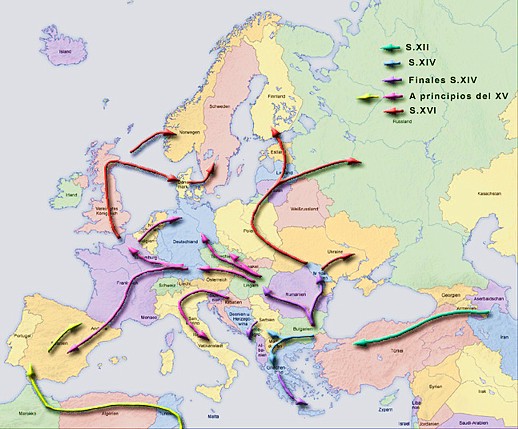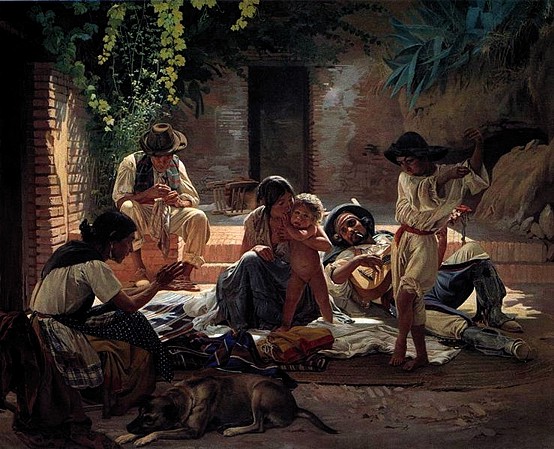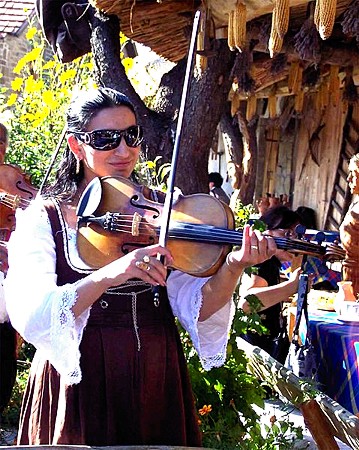Lessico
Zingaro
Zigano o Tzigano
Vessillo internazionale dei Rom dal 1971
Zigano viene dal francese tsigane, dall'ungherese cigány, per adattamento del greco medievale athinganos, popolarmente atsinganos = intoccabile. Col nome di zingari vengono impropriamente designati in Italia i nomadi provenienti dall'Est dediti in prevalenza all'accattonaggio, al piccolo contrabbando, all'artigianato e alla chiromanzia. Correttamente il nome deve essere dato, come in passato, alla sola etnia dei Rom - gli uomini – che parla una lingua propria (romesh) della famiglia indoiraniana.
Gli zingari Rom conservano tuttora i caratteri antropologici di un tipo fisico particolare del gruppo europoide: cranio dolicomorfo; faccia lunga e stretta con naso prominente e affilato; occhi scuri leggermente allungati e incavati; bocca larga con labbra spesse; corporatura longiforme e statura alta; capelli lunghi, ondulati e scarsa pelosità; pelle di colore bruno-scuro.
Gli zingari Rom, chiamati nei Paesi danubiani Tzigani, in Spagna Gitanos, nei Paesi anglosassoni Gipsies o Gypsies (provenienti dall’Egitto come si riteneva nel XVI sec.), in Francia Bohémiens, penetrarono in Europa verso il secolo X provenienti dalle regioni nord-orientali dell'India. Tentarono di stabilirsi nella valle del Danubio ma si scontrarono con le genti slave che ne provocarono la dispersione. La maggioranza migrò verso l'Europa occidentale e settentrionale, una parte restò nella Penisola Balcanica e altri si rifugiarono nei Paesi dell'Est.
Le comunità più numerose, che mantennero il tradizionale modo di vivere nomade, si costituirono in Iugoslavia, Romania, Ungheria, Germania, Italia, Francia e soprattutto Spagna (dove ancor oggi conta il maggior numero di rappresentanti); piccole unità migrarono anche in Armenia e Anatolia. Ovunque, però, furono isolate dagli abitanti locali, il che accentuò il carattere indipendente e l'unità di stirpe di questo popolo e ne caratterizzò sempre più il modo di vivere da girovaghi.


Gypsy may refer to:
Roma people
Ruska Roma
Gitanos, also spelled Ciganos, mostly in Spain, Portugal, and southern France (Tsigane)
Norwegian and Swedish Travellers, a Romani people in Norway and Sweden
Romnichal, also known as Rom'nies, mostly in Britain and North America
Irish Travellers, also known as Pavee, mostly in Ireland, Great Britain, and the United States
Sea Gypsies, a number of different peoples of Southeast Asia
Yeniche (people), mostly in Germany, Austria, Switzerland, France, and Belgium
Roma in Spain
The Romani people (also called Romany or Gypsies) are a diverse ethnic group who until recently lived primarily in Southern and Eastern Europe, Western Asia, and the Middle East. The Roma in Spain are generally known as Gitanos. They used to speak a language known as Romani. Spanish Roma tend to speak Caló which is basically Andalusian Spanish with a large number of Romani loan words. Estimates of the Spanish Gitano population fluctuate between 600,000 and 800,000 with the Spanish government estimating a number between 650,000 and 700,000.
History
It is generally accepted that the Roma migrated out of the Indian subcontinent into Europe as early as the eleventh century. While in most of Europe the Roma arrived from Asia through Eastern Europe, there are records of their having arrived in Spain from Northern Africa, as early as 1425 and in Barcelona and Zaragoza, in particular, by 1447. At first they were well received and were even accorded official protection by many local authorities, but by 1492 the first anti-Gypsy law was passed in Spain. Spanish Roma are linked to Flamenco and have contributed a great deal to this Andalusian musical art. According to Blas Infante, in his book Orígenes de lo flamenco y secreto del cante jondo, etymologically, the word Flamenco comes from Andalusi Arabic fellah mengu, "Escapee Peasant". Infante connects the huge amount of Muslim Andalusians who decided to stay and mix with the Romani newcomers instead of abandoning their lands because of their religious beliefs (Moriscos).
After the Castilian reconquest of Andalusia, the Reconquista, most of the land was expropriated and given to warlords and mercenaries who had helped the Castilian kings enterprise against Al-Andalus. When the Spanish Crown later ordered the expulsion or forceful conversion of the Andalusian Moriscos, many of them took refuge among the Gypsies, becoming fellah mengu in order to avoid persecution, or forced deportation. In 1492 the Gypsies were included too in the list of peoples to be assimilated or driven out. For about 300 years, Gypsies were subject to a number of laws and policies designed to eliminate them from Spain as an identifiable group: Romani settlements were broken up and the residents dispersed; sometimes, Gypsies were even required to marry non-Gypsies; they were denied their language and rituals as well as being excluded from public office and from guild membership.
Gypsies worked as nomadic beast traders or entertainers. The sedentary population (payos, "Gadjos") saw them as both dangerous, accusing them of laziness, stealing and kidnapping children, and attractive, bringing novelties from the outer world, having magical powers of palmistry and living freely and carelessly.
Under Francisco Franco, Gypsies were harassed or simply ignored, although their children were, albeit sometimes forcibly, schooled. In the post-Franco era, however, Spanish government policy has been much more sympathetic toward them, especially in the area of social welfare and social services. Since 1983, for example, the government has operated a special program of compensatory education to promote educational rights for the disadvantaged, including those in Romani communities. The challenge will be to devise programs that bring the Romani population into the mainstream of the country's economic and political life without eroding the group's distinctive cultural and linguistic heritage.
During the 1980s, the Romani communities were devastated by heroin addiction. Many of the Romani slums around big cities have become what media calls "drug supermarkets", areas where addicts to heroin (Romani or otherwise) go to buy their doses, and where the police apply containment, rarely attacking the dealers. About 25% of the female prisoners in Spain are Gitanas, most of them directly or indirectly related to drug traffic. At the same time, many Spanish Gypsies have found soothing to their lives in Evangelic Christianity, where the church has incorporated Flamenco in their worship.
Religion
Gitanos were traditionally Roman Catholics who participate in four of the church's sacraments (baptism, marriage, confirmation, and extreme unction), but they are not assiduous churchgoers. They rarely go to folk healers, and they participate fully in Spain's state-supported medical system. Gitanos have a special involvement with recently dead kin, visit their graves frequently, and spend a great deal more money than non-Gitanos of equivalent economic classes in adorning grave sites.
At present, more than a half of all Gitanos have joined the Evangelical faith. This fact has contributed to a better social status and cultural development. Even non-Evangelical Gitanos usually call the pastors for important ceremonies as funerals. The Romani Evangelical Assembly is the only religious institution entirely led and composed by Roma.
The traditional Spanish Gypsies place a high value on the extended family. Virginity is essential in unmarried women. Both men and women often marry young.

Groups
Spanish Roma are called gitanos. In the late 1980s, the gitanos lived predominantly in southern and central Spain. Many of them took up a sedentary form of life, working as junk collectors, street vendors or entertainers, as well as stealing and committing other petty crimes. Poor and largely illiterate, they have never been integrated into Spanish society.
Gitanos is a Spanish name, in southern France they are known as Gitans or more generally Tsiganes (includes the other French Roma) and in Portugal they are known as Ciganos. Similarly to the English word Gypsy, the name Gitano comes from Egiptiano (Egyptian), because in past centuries it was thought their origins were in the country of Egypt. After losing their original Romani language, they used Caló, a jargon with Spanish grammar and some Romani vocabulary (although very little). "Caló" means "dark" in Caló and the Caló word for "Gitano" is calé, also "the dark ones". Caló is one of the influences of later Germanía and modern Spanish slang.
There is also a current trend of migration of Romanian, Slovak and Muslim Moroccan Roma into the country.